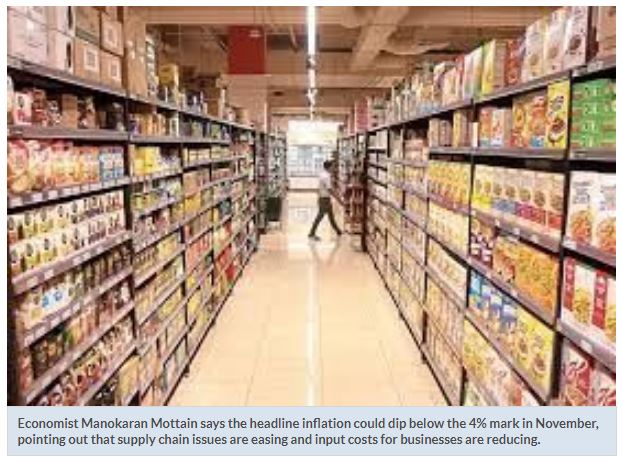Inflationary pressures easing in Malaysia
PETALING JAYA: Inflationary pressures are expected to normalise further, continuing a downtrend seen in Malaysia’s headline inflation figures after peaking at 4.7% in August 2022.
However, the unpleasant news is that domestic inflation is likely to remain above a level which economists and Bank Negara consider as “elevated.”
Based on a poll by Reuters, economists projected the headline inflation for November to be 3.9% on a year-on-year (y-o-y) basis, down from 4% y-o-y in October.
In September, the headline inflation was recorded at 4.5% y-o-y. The Statistics Department is scheduled to announce the indicator for inflation – the Consumer Price Index (CPI) – for November today.
Economist Manokaran Mottain told StarBiz that the headline inflation could dip below the 4% mark in November, pointing out that supply chain issues are easing and input costs for businesses are reducing.
“However, the biggest drop in inflation will come in December and the months onwards.
“The ringgit’s strengthening against the US dollar will reduce import costs and the new government’s measures to control food prices will also ease inflationary pressures,” said Manokaran, who is also a director at Malaysia Venture Capital Management Bhd.
When asked whether a slowdown in inflation would influence Bank Negara’s overnight policy rate (OPR) decisions, Manokaran said the central bank may “wait and see” before deciding on its monetary policy direction.
He also expects Bank Negara to “take a pause” in its Monetary Policy Committee meeting next month.
Between May and November 2022, Bank Negara had raised the OPR by 100 basis points cumulatively to 2.75% from the record-low rate of 1.75%.
Meanwhile, Socio-Economic Research Centre (SERC) executive director Lee Heng Guie told StarBiz that the country’s headline inflation is estimated to increase by 4% y-o-y in November.
This would reflect the base effects of electricity prices and cheaper non-subsidised RON97 fuel prices, amid the still firm prices in the services sector.
He pointed out the absence of base effects attributed to the discontinuation of electricity discounts under the National People’s Well-Being and Economic Recovery Package from July to September 2021.
Commenting on core inflation, Lee expects it to continue to inch higher, reflecting a broadening of price pressures and reinforced by consumer demand pressure.
It is noteworthy that Malaysia recorded a core inflation of 4.1% y-o-y in October 2022, exceeding the headline inflation for the month.
The biggest contributor to core inflation in October was the food and non-alcoholic beverages group in the CPI, rising by 7.9%.
In addition, the transport group also recorded an increase of 7.7%, followed by restaurants and hotels (6.8%); furnishing, household equipment and routine household maintenance (4.1%) as well as recreation services and culture (3.4%).
Core inflation measures the change in prices of all goods and services, excluding volatile items such as fresh food as well as administered prices of goods by the government.
Earlier last month, Bank Negara said Malaysia’s underlying inflation, as measured by core inflation, is projected to average closer to the upper end of the 2% to 3% forecast range in 2022.
Moving into 2023, the central bank expects the country’s headline and core inflation are expected to remain elevated amid both demand and cost pressures, as well as any changes to domestic policy measures.
“The extent of upward pressures to inflation will remain partly contained by existing price controls, subsidies, and the remaining spare capacity in the economy.
“The balance of risk to the inflation outlook in 2023 is tilted to the upside and continues to be subject to domestic policy measures on subsidies, as well as global commodity price developments arising mainly from the ongoing military conflict in Ukraine and prolonged supply-related disruptions,” it said.
Going forward, SERC’s Lee said the changes in domestic policies on subsidy rationalisation will exert some pressures on inflation.
He also added that the targeted subsidy rationalisation has to be implemented gradually, accompanied by additional cash handouts or coupons to the affected group.
This is intended to partially mitigate against the impact of inflation and higher cost of living.
“For now, no electricity tariff hikes for households and small and medium enterprises in 2023.
“The government has yet to decide on the fuel subsidy rationalisation amid still high global crude oil prices,” according to Lee.
Echoing a similar projection like Lee, HELP University economics professor Paolo Casadio forecasts November’s headline inflation rate at 4% y-o-y.
“I expect to see headline inflation data for November reflecting a transition from the peak of 4.7% in August to a rate of 3.5% in the first two months of 2023, and to go toward 2.5% after mid-year,” he said.
However, Casadio cautioned that any spike in crude oil prices would cause an uptick in inflationary pressures.
On the stubbornly high core inflation, Casadio said this was caused by the boom in some service-based businesses post-reopening of the economy such as hotels and restaurants as well as recreation and other entertainment-based businesses.
In addition, there is the “effective negative effect” from the rise in the electricity tariff last year, according to him.
“The negative effects of these factors are fading and that’s why inflation can go down in many services.
“In my opinion, a cut in the electricity tariff could be a great incentive for consumers and businesses as well as to induce a virtuous cycle insulating Malaysia from the negative evolution of the rest of the world,” he said.
Source: https://www.thestar.com.my/business/business-news/2022/12/23/inflationary-pressures-easing-in-malaysia


 Thailand
Thailand




